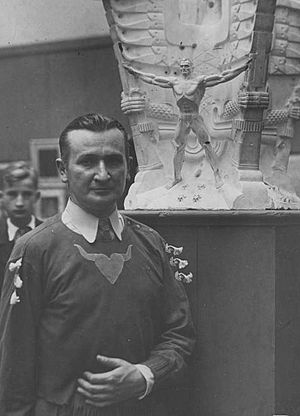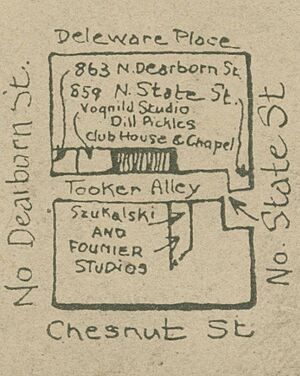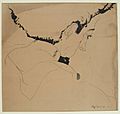Stanisław Szukalski facts for kids
Quick facts for kids
Stanisław Szukalski
|
|
|---|---|

Stanisław Szukalski in Kraków 1936.
|
|
| Born | 13 December 1893 Warta, Congress Poland
|
| Died | 19 May 1987 (aged 93) Burbank, California, U.S.
|
| Nationality | Polish, American |
Stanisław Szukalski (born December 13, 1893 – died May 19, 1987) was a famous Polish sculptor and painter. He became a key part of the "Chicago Renaissance," a time when art and culture grew in Chicago.
Szukalski's art mixed ideas from old cultures like Egyptian, Slavic, and Aztec art. He also used styles from early 1900s modern art, such as cubism and expressionism. People called his unique art style "Bent Classicism." In the 1920s, many saw him as Poland's "greatest living artist."
He also created a special theory called Zermatism. This idea suggested that all human culture came from Easter Island after a great flood. He also believed that humans were always fighting against the "Yetinsyny," who were the children of the Yeti and humans.
Contents
Life of Stanisław Szukalski
Early Life and Art Training
Stanisław Szukalski was born in Warta, Poland. He grew up in a town called Gidle. In 1907, when he was 13, he moved to New York with his mother and sister. They then went to Chicago to join his father, who was a blacksmith.
Stanisław was a very talented sculptor even as a child. At 13, he started studying at the Art Institute of Chicago. A year later, another sculptor, Antoni Popiel, convinced Stanisław's parents to send him back to Poland. There, he studied sculpture at the Academy of Fine Arts in Kraków for three years. He returned to Chicago in 1913.
Art Scene in Chicago
Back in the U.S., Szukalski became an important artist in Chicago. In 1914, he showed seven of his sculptures at a big art exhibition. He had his own art shows at the Art Institute in 1916 and 1917. He also showed his work at the Arts Club in 1919. In 1922, he married Helen Walker.
Mickiewicz Monument Design
In 1925, a competition was held to design a monument for Adam Mickiewicz. He was a famous Polish poet. The monument was planned for the city of Vilnius. Many artists submitted their designs.
Szukalski won first prize in this competition. His design showed Mickiewicz lying on a special altar. The sculpture would sit on a large base shaped like an Aztec pyramid. A White Eagle, a symbol of Poland, was next to the figure. It looked like it was drinking blood from the poet's wound.
Szukalski's design caused a lot of debate among people in Poland. Some loved it, others strongly disliked it. Because of this, a new competition was held. Another artist, Henryk Kuna, won this time. However, the monument was never built due to money problems and World War II.
Travels and New Ideas
In 1925, Szukalski showed his art in Paris, France. He won many awards there. But some Polish newspapers criticized him because he didn't live in Poland. In 1926, his only child, a daughter named Elżbieta Kalina, was born in Paris.
After traveling in Europe, Szukalski went to Kraków, Poland, in 1929. He had a big art show there. In 1929, he also helped start an art group called "Tribe of the Horned Heart." This group focused on Polish artists who found ideas in Poland's ancient, pre-Christian history.
In 1929, Szukalski published a book called Projects in Design: Sculpture and Architecture. It had many drawings of his ideas for buildings and monuments. In 1932, he and Helen divorced. In 1934, he married Joan Lee Donovan in Hollywood.
Return to Poland and War
In 1936, Szukalski moved back to Poland. The government supported him financially. He created several sculptures, including a monument of Bolesław Chrobry. He also decorated buildings in the city of Katowice. Poland declared him the country's greatest living artist.
The government gave him a large studio in Warsaw. They called it the Szukalski National Museum. This museum held many of his paintings and huge sculptures. These artworks were known for their dramatic, mythological images. Szukalski had brought most of his life's work to Poland.
In September 1939, Germany attacked Warsaw. Szukalski was hurt in the bombing. Much of his studio and artwork were destroyed. Szukalski and his wife were American citizens. They found safety in the U.S. embassy. They eventually escaped Poland and returned to the United States.
Szukalski had hoped to build a museum for his art in Poland. But he lost almost all his work there. What wasn't destroyed by bombs was ruined by the German army.
Life in California
In 1940, Szukalski and his wife settled in Los Angeles. Szukalski worked odd jobs in film studios. He designed scenery and sometimes sculpted.
In his later years, Szukalski worked on several big sculpture projects. These included Prometheus (1943) and Rooster of Gaul (1960). He also designed Katyn (1979), a monument for Polish officers killed in World War II. None of these large projects were fully built.
In 1971, a publisher named Glenn Bray became friends with Szukalski. Bray published books about Szukalski's art and ideas. These books helped other people discover Szukalski's work. One of these people was George DiCaprio, the father of actor Leonardo DiCaprio. George DiCaprio became a close friend of Szukalski.
Szukalski's second wife, Joan, died in 1980. Szukalski passed away in 1987. A group of his admirers spread his ashes on Easter Island.
Zermatism: Szukalski's Unique Theory
Starting in 1940, Szukalski spent most of his time studying ancient human history. He looked into how languages, beliefs, customs, and art began. He tried to figure out where names of places, gods, and symbols came from.
Through his research, Szukalski claimed to have found Polish origins for many ancient places and people. He called this original language "Protong." According to Szukalski, you could see Protong in everything. He even believed that Babylon and Jesus had Polish roots. He wrote a huge book called Protong (or Macimowa in Polish). He worked on it for over 40 years.
This book had 42 volumes, more than 25,000 pages, and 14,000 drawings. His drawings of old objects were meant to prove his theories.
Zermatism was Szukalski's idea of world history. He believed that all human culture came from people who lived on Easter Island after a great flood. These people then settled in a place called Zermatt (which is where the name "Zermatism" comes from). He thought that all human languages had traces of this original, ancient mother-tongue. He believed this language had old Polish origins.
In his view, humans were always fighting against the "Yetinsyny." These were the children of the Yeti and humans. He claimed they had controlled humanity for a very long time. He even said that the god Pan in Greek art showed creatures that really existed. These creatures were the result of Yeti apes. Szukalski used his amazing art skills to draw pictures for his theories. Even though his ideas were not scientific, many people found his art beautiful and interesting.
Artistic Legacy and Influence
Glenn Bray and his wife Lena Zwalve now manage Szukalski's art and writings. Their group is called "Archives Szukalski." In 1990, they published a book of photos of Szukalski's early artworks.
Many people admire Szukalski's work. These include actor Leonardo DiCaprio, who helped fund an art show called "Struggle" in 2000. The band Tool and artist H. R. Giger are also fans. Artist Ernst Fuchs even said, "Szukalski was the Michelangelo of the 20th century."
Szukalski's artworks are always on display at the Polish Museum of America in Chicago. Sadly, none of his work in Warsaw survived World War II. Besides the show Leonardo DiCaprio sponsored, other important exhibitions of his work have been held. These include "The Self-Born" in San Francisco in 2005.
In 2018, Leonardo DiCaprio produced a documentary film about Szukalski. It was called Struggle: The Life and Lost Art of Szukalski. This film was released on Netflix.
Images for kids
-
Bolesław II the Generous, bronze, from 1926 to 1928, Upper Silesian Museum, Bytom
See also
 In Spanish: Stanisław Szukalski para niños
In Spanish: Stanisław Szukalski para niños







